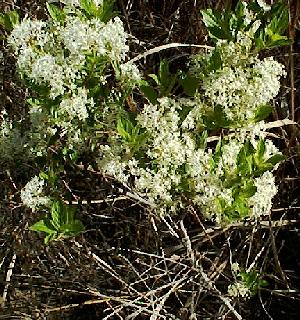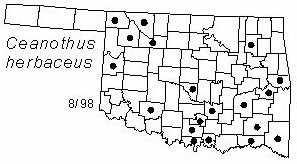 Shrub, to 1 m (3 ft) tall. Twigs green, brown or tan, slender, puberulent. Leaves alternate, simple; elliptic, 1.9-6.4 cm (0.75-2.5 in) long, 1-2.5 cm (0.4-1 in) wide; glabrous, but may be lightly pubescent beneath; dull green, paler beneath; cuneate at base, acute or obtuse at apex, margins crenate to serrate with gland tipped teeth; petiole 0.3-1.3 cm (1/8-1/2 in) long, pubescent to glabrous. Inflorescence a panicle of many flowers on peduncles 0.6-5 cm (1/4-2 in) long; calyx 5-lobed; petals 5, white, spreading and hooded; styles single, 3-lobed; stamens 5, exerted; flowers appear from April to July. Fruits capsules, 0.5 cm (1/5 in) in diameter; black; fruits mature August to September.
Shrub, to 1 m (3 ft) tall. Twigs green, brown or tan, slender, puberulent. Leaves alternate, simple; elliptic, 1.9-6.4 cm (0.75-2.5 in) long, 1-2.5 cm (0.4-1 in) wide; glabrous, but may be lightly pubescent beneath; dull green, paler beneath; cuneate at base, acute or obtuse at apex, margins crenate to serrate with gland tipped teeth; petiole 0.3-1.3 cm (1/8-1/2 in) long, pubescent to glabrous. Inflorescence a panicle of many flowers on peduncles 0.6-5 cm (1/4-2 in) long; calyx 5-lobed; petals 5, white, spreading and hooded; styles single, 3-lobed; stamens 5, exerted; flowers appear from April to July. Fruits capsules, 0.5 cm (1/5 in) in diameter; black; fruits mature August to September.
Distribution: Oklahoma, central Texas, and Arkansas east to Florida, north to Quebec, west to Minnesota and South Dakota. Common in Oklahoma.
Habitat: slopes composed of calcareous rocks.
Comments: Ceanothus is an ancient name, the meaning of which is unclear; herbacea refers to leafy
branchlets. Nitrogen-fixing nodules affix to the roots.
Horticulture: Propagated by seeds, cuttings, and layering. It is recommended that seeds be soaked in warm water and stratified. Redroot tolerates hot, dry conditions.
Wildlife benefits: Seeds are eaten by birds.
NWI status: none
Distribution in Oklahoma: 
BACK
NEXT
RETURN TO INDEX
Last update: 9/9/99
 Go to Oklahoma Biological Survey Home Page
Go to Oklahoma Biological Survey Home Page
 Disclaimer
Disclaimer